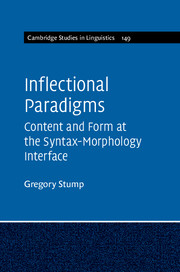Book contents
- Frontmatter
- Dedication
- Contents
- List of figures
- List of tables
- Acknowledgements
- List of abbreviations
- List of symbols and operators
- Introduction
- 1 What are inflectional paradigms?
- 2 Canonical inflectional paradigms
- 3 Morphosyntactic properties
- 4 Lexemes
- 5 Stems
- 6 Inflection classes
- 7 A conception of the relation of content to form in inflectional paradigms
- 8 Morphomic properties
- 9 Too many cells, too few cells
- 10 Syncretism
- 11 Suppletion and heteroclisis
- 12 Deponency and metaconjugation
- 13 Polyfunctionality
- 14 A theoretical synopsis and two further issues
- References
- Index
10 - Syncretism
Published online by Cambridge University Press: 18 December 2015
- Frontmatter
- Dedication
- Contents
- List of figures
- List of tables
- Acknowledgements
- List of abbreviations
- List of symbols and operators
- Introduction
- 1 What are inflectional paradigms?
- 2 Canonical inflectional paradigms
- 3 Morphosyntactic properties
- 4 Lexemes
- 5 Stems
- 6 Inflection classes
- 7 A conception of the relation of content to form in inflectional paradigms
- 8 Morphomic properties
- 9 Too many cells, too few cells
- 10 Syncretism
- 11 Suppletion and heteroclisis
- 12 Deponency and metaconjugation
- 13 Polyfunctionality
- 14 A theoretical synopsis and two further issues
- References
- Index
Summary
In the last chapter, I examined the phenomenon of form defectiveness, the existence of content paradigms some of whose cells unexpectedly lack any form correspondent (and hence any realization) – unexpectedly in the sense that there is no syntactic or semantic justification for this lacuna in their realization. Here, I examine another phenomenon in which cells in a lexeme's content paradigm outnumber the form cells through whose mediation they get their realization. This phenomenon – syncretism – is unlike defectiveness because it doesn't leave content cells unrealized; instead, it is the realization of two or more content cells through the mediation of a single form cell.
Instances of syncretism are of various kinds. In instances of natural-class syncretism, a morphosyntactically coherent set of content cells has a common realization (Section 10.1). Syncretisms that don't simply encompass a natural class of content cells are of two kinds. In cases of directional syncretism, the realization of one property set systematically patterns after that of some distinct property set (Section 10.2); in instances of morphomic syncretism, two or more property sets that do not form a natural class are nevertheless alike in their realization and neither set is associated with that realization independently of the other set (Section 10.3). Drawing on evidence from Bhojpuri, Turkish and Sanskrit, I discuss several examples embodying these distinctions. As I show, the paradigm-linkage hypothesis affords a simple way of understanding each of these kinds of syncretism. More generally, the phenomenon of syncretism provides clear motivation for both the irreducibility hypothesis and the interface hypothesis (Section 10.4).
Natural-class syncretism
In the simplest examples of syncretism, the syncretized cells in a lexeme's paradigm belong together in that their property sets constitute a natural class. Consider again the synthetic inflection of the Bhojpuri verb dēkh ‘see’ in Table 10.1. These forms are built on two morphomic stems: The shaded forms exhibit the long stem dēkh- and the remaining forms, the short stem dekh-. As was seen in Section 3.7, the word forms arising from these stems present numerous instances of syncretism in which the syncretized forms all realize a natural class of morphosyntactic properties.
Information
- Type
- Chapter
- Information
- Inflectional ParadigmsContent and Form at the Syntax-Morphology Interface, pp. 170 - 183Publisher: Cambridge University PressPrint publication year: 2015
